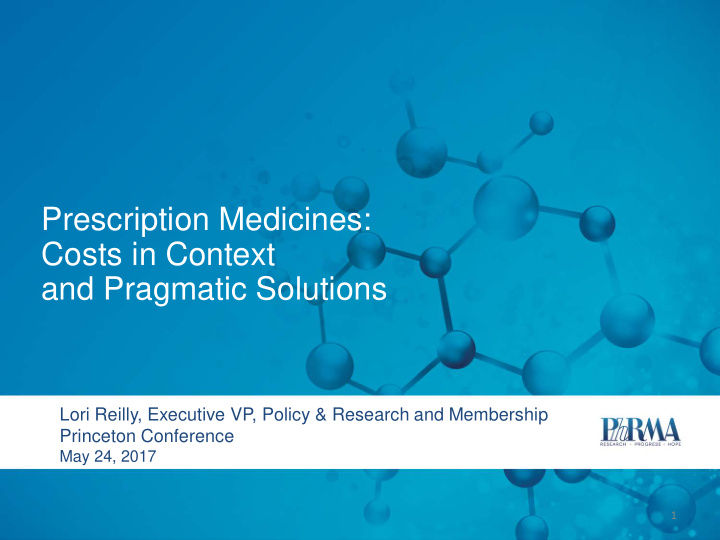



Prescription Medicines: Costs in Context and Pragmatic Solutions Lori Reilly, Executive VP, Policy & Research and Membership Princeton Conference May 24, 2017 1
U.S. Health Care System Faces Significant Challenges Increased cost Access restrictions, Aging population sharing for patients narrow networks Rising insurance Greater prevalence Suboptimal health premiums of chronic diseases outcomes 2
Medicines are Transforming the Treatment OF DEVASTATING DISEASES HEPATITIS C The leading cause of liver transplants and the reason liver cancer is on the rise – is now curable in more than 90 percent of treated patients.* November 16, 2015 Gov. Hogan’s Cancer is in Rem ission, 30 Days After CANCER He Com pleted Chem o New therapies have contributed to a 23% decline in the cancer death rate since its peak in 1991. Today, 2 out of 3 people diagnosed with cancer survive at least 5 years.** December 6, 2015 HIGH CHOLESTEROL Form er President America’s biopharmaceutical companies are Jim m y Carter Says He is currently developing 190 medicines to treat heart Free of Cancer disease, stroke and other cardiovascular diseases. New PCSK9 inhibitors have revolutionized high cholesterol treatment. Between 1991 and 2011, the death rate from heart disease dropped 46%.***
Prescription Medicine Spending Growth: 2008-2025 * After growing 12.2% in 2014, government actuaries project prescription drug spending growth to moderate over the next few years to 6-8% through 2025, in line with overall health spending 2014 saw a record 41 medicines approved by the FDA – including a number of 14% transformative medicines for debilitating diseases – as well as 15.7 million Americans 12.4% 12% Percent Annual Growth Rate gaining coverage through the ACA. 10% 9.0% 8% 7.6% 6.4% 6.3% 6.3% 5.7% 6.4% 6.4% 6.4% 6.4% 6% 5.0% 4.7% 4% 2.5% 2.3% 2.3% 2% 0.1% 0.2% 0% Total Health Expenditure Growth Rate Prescription Drug Growth Rate *Total retail sales including brand medicines and generics Source: Centers for Medicare & Medicaid Services (CMS) 1 2
Multiple Data Sources Confirm DRAMATIC SLOWDOWN IN PRESCRIPTION MEDICINE SPENDING GROWTH Accounting for discounts and rebates, net spending growth rates in 2016 dipped to between 2% and 4% IMS reported that the 2016 net prescription medicine spending CVS Health reported that net prescription medicine spending for its growth rate was between 2% to 3% clients grew by 3.6% in the first half of 2016 Altarum Institute reported that the 2016 prescription medicine Express Scripts reported that net prescription medicine spending growth rate of 4.0% was lower than the growth rates for spending growth for its clients was 3.8% in 2016 physician and hospital spending CMS reported that spending growth for prescription medicines fell by nearly a third between 2014 and 2015, from 12.4% to 9.0% 3 • Market Dynamics
Medicines Account for a STABLE SHARE OF HEALTH CARE SPENDING
Spending on Brand Medicines Falls Dramatically as MEDICINES FACE GENERIC COMPETITION
Medical Procedures Become More Expensive Over Time, BUT COST CONTAINMENT IS BUILT INTO THE MEDICINE LIFE CYCLE 8
The “Blank Check” Myth Payers Have Significant Leverage to Negotiate Rebates and Discounts Insurers and PBM Market Share, by Total Equivalent Prescriptions PBMs determine: FORMULARY if a medicine is covered TIER PLACEMENT patient cost sharing ACCESSIBILITY utilization management through prior authorization or fail first PROVIDER INCENTIVES preferred treatment guidelines and pathways NOTE: OptumRx and Catamaran merged in 2015. Their 2014 shares are shown combined. 9
GROWTH IN OTHER HEALTH CARE SERVICES WILL BE FIVE TIMES Total Medicine Spending Growth Through Next Decade Projected Annual Growth in Spending ($ Billions) (10-year cumulative increase: (10-year cumulative increase: $1,950 billion) $393 billion)
According to PBMs, Medicine Prices and Spending Growth Are Declining Brand Drug Prices Spending Growth 2014 12-13% 10.7% LIST 2015 5% 2.5% NET 3-4% 2016 Express Scripts experienced only a 2.5% Express Scripts, CVS Health, and OptumRx increase in unit costs across all prescription all report spending growth of 3-4% in 2016. medications—nearly 22% lower than 2015, and more than 60% lower than the increase Government data show medicines had the in prices, net of rebates . largest decline in spending growth of all health care categories between 2015 and 2016. 11
Public List Prices Don’t Reflect What Insurers Actually Pay
Trends in List Price Mask Impact of Growing Discounts 1/3 of brand medicine list prices Rebates, discounts and fees are rebated back to payers, government increasing for brand medicines or retained by supply chain $106.4B 6.9% $84.6B 12% $67 B 18.5% 62.6% Brand Companies Market Access Rebates and Discounts Statutory Rebates and Fees 2013 2014 2015 Supply Chain Entities Berkeley Research Group 13
New Reality of Insurance Coverage of Medicines Cost-sharing outpacing Increased use of deductibles underlying medical costs In 2015, 46% of commercial health plans From 2004-2014, enrollee payments required a deductible for prescription increased 256% for deductibles and 107% drugs, double the number in 2012. for coinsurance. At the same time, insurer costs increased only 58%. Increase use of fail first and Incentivized prescribing prior authorization requirements Health plans increasingly incentivize Utilization management more providers to follow set treatment than doubled in employer plans pathways. from 2014 to 2016. 14
Policies to Advance a Value Driven Health Care System Modernize Drug Engage and Value Based Development and Empower Contracting Discovery Consumers Better Quality Address Market Measurement and Appropriate Use of Distortions Value Assessment Medicines Tools 15
Recommend
More recommend